Physical Address
304 North Cardinal St.
Dorchester Center, MA 02124
A reactive/reparative process characterized by proliferation of axons, Schwann cells, and perineurial fibroblasts in a disorganized pattern in the background of collagenous stroma (scar) at the proximal end of an injured/severed peripheral, cranial, or autonomic nerve
Causally related to trauma to a nerve as a result of diverse etiologies, most commonly surgical procedure
Peripheral sensory nerve(s) most commonly affected, followed by motor sensory nerves and autonomic nerves
No gender predilection
No age predominance
Frequency varies according to the underlying causative event
Less than 3% of patients after radical neck dissection
As high as 26% of patients after bilateral limb amputation
Associated conditions, in addition to previous surgery, include burns, trauma, minor trauma (not readily apparent), human bite, arteriovenous aneurysm, nuchal- and extranuchal-type fibroma
Solitary firm nodule or a raised, occasionally erythematous area within a preexistent scar
Not fixed to the underlying tissue
Generally measures less than 1 cm in greatest diameter
Usually painful, but asymptomatic examples not uncommon
Other sensory abnormalities include paresthesia, anesthesia, tenderness, and hypersensitivity
Multiple lesions infrequent
Genital locations
May be associated with previous burns
Site of origin generally related to the site of previous trauma and most commonly includes extremities and the head and neck area
Mucosal surfaces (e.g., oral cavity) can also be affected
Uncommon sites include intraosseous occurrence, subungual area, and penis
Treatment options include nonsurgical methods (injections of steroids, sympathetic ganglion block, therapy by ultrasound) with variable success, as well as surgical excision
Complete surgical excision usually curative, but recurrences not uncommon, and multiple procedures may be needed
Disorganized/haphazard proliferation of all the elements of the nerve fascicle, including axons, Schwann cells, and perineural fibroblasts, in the dermis and/or subcutis
Variably cellular collagenous and hyalinized stroma in the background (scarring)
Cleft-like spaces between components of the lesion and stroma
Additional features
Intraepithelial proliferation of axons overlying the lesion has been described at mucosal sites
Granular cytoplasm of Schwann cells with centrally placed uniform nucleoli exceptionally reported in lesions developing in the breast
Mature ganglion cells, occasionally in clusters, with accompanying satellite cells
Dystrophic calcification
Mast cells in variable proportions
Chronic inflammation
Mucinous change in the stroma
Perineural and intraneural infiltration of nerve bundles by neoplastic cells reported in an exceptional case of squamous cell carcinoma and microcystic adnexal carcinoma
Accessory digit
Mucosal neuroma
Schwannoma
Neurofibroma
Ganglioneuroma
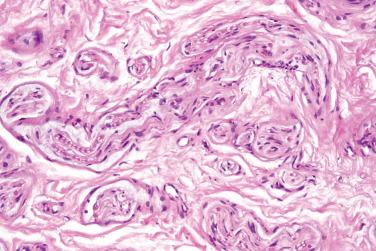
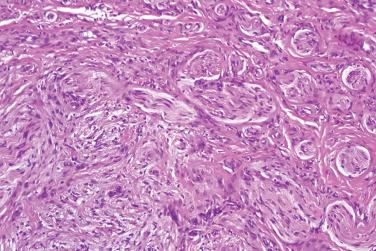
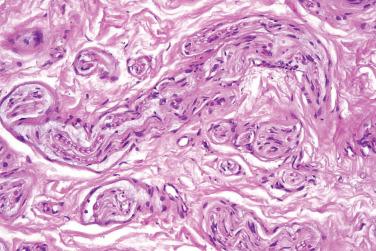
A variant of neuroma characterized by aggregates of hyperplastic Pacinian corpuscles surrounded by increased numbers of small nerve fibers and mild pericorpuscular, perineural, and endoneural fibrosis
Probably not a true neoplasia, but likely rather represents a distinctive form of a hyperplastic tissue response
No gender predilection
Middle-aged adults
Congenital occurrence in a single patient
About 50% of lesions associated with previous trauma
One lesion associated with Morton neuroma
Progressive, sometimes excruciating pain in the affected digit, radiating to the arm
Local tenderness
Localized swelling or small, palpable nodule
Solitary lesions predominate, but multifocal occurrence possible
Site of occurrence includes fingers and toes
Complete excision associated with immediate relief of symptoms
No recurrences reported
Main components of the lesion include Pacinian corpuscles, nerve fibers, and fibrosis
Pacinian corpuscles increased in numbers (hyperplasia) and size (hypertrophy)
Composed of central axon surrounded by a discontinued single Schwann cell layer and lamellae of perineurial cells
Pericorpuscular fibrosis generally present, but usually mild
Small nerve fibers increased in numbers
In between Pacinian corpuscles
Endoneural and perineural fibrosis
Additional histological features
Foreign body granuloma
Traumatic neuroma
Mild inflammation
Erosive changes of the proximal phalanx reported in a single case
Neurotized melanocytic nevus
Traumatic neuroma
Pacinian schwannoma
Pacinian neurofibroma
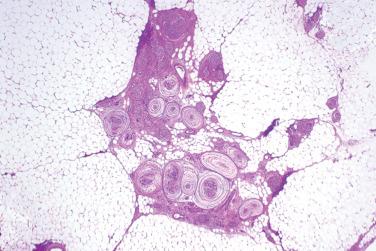
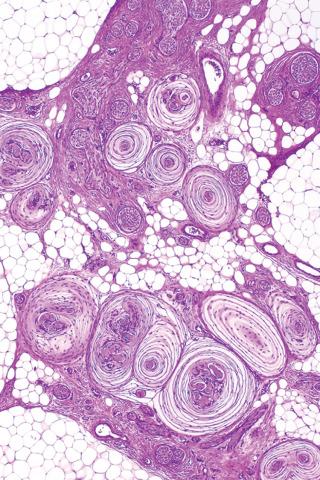
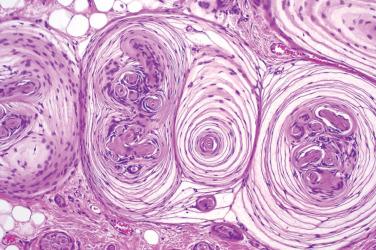
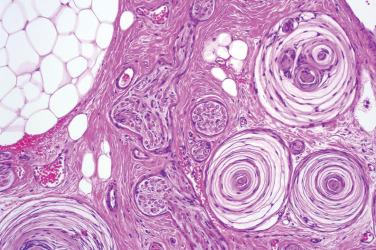
An entrapment-related degenerative neuropathy, not a true neuroma, with a strong predilection for the third common digital nerve of the foot
Recognized morphologically by edema and hypertrophy of the affected nerve with associated degenerative changes, including degeneration/demyelinization of axons, intraneural and perineural fibrosis/sclerosis, and proliferation/hyalinization of intraneural vessels
Striking female predominance (F:M = 5–10 : 1)
Different age groups can be affected, but most common between 40 and 60 years of age
Fullness with enlargement of the interdigitating space with subsequent thickening
Well-defined mass or nodule generally not seen
Forefoot pain, irritating and debilitating at the bottom of the foot, usually on walking
Tenderness and paresthesia
Size of the lesion from 0.7 to 2.0 cm (mean size 1.1 cm)
Predilection for third to fourth web interspace of the foot, followed by second to third web interspace, but distal sites to the metatarsal heads not uncommonly affected
Associated conditions can include rheumatoid nodules at the same site(s) in the setting of rheumatoid arthritis
Multiple lesions rare
Gradual onset, but slowly progressive if left untreated
Nonsurgical treatment options include activity modification, use of appropriate footwear, nonsteroidal anti-inflammatory drugs, sonography-guided alcohol injections, injection of local anesthetics, and corticosteroids
Radiofrequency ablation and surgical neurectomy
Thickening of the affected nerve
Degeneration and demyelinization of nerve fibers
Fibrosis/sclerosis of the epineurium, perineurium, and endoneurium
Proliferation, hyalinization, and sclerosis of endoneurial vessels
The diagnosis is generally made on clinical grounds
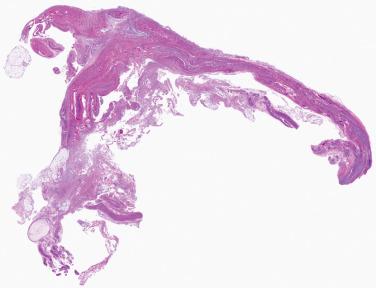
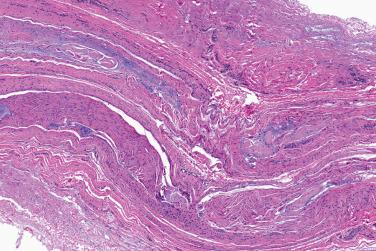
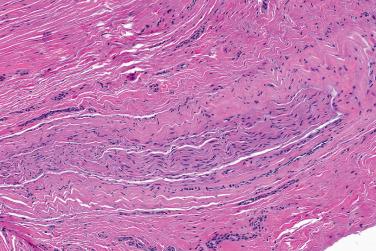
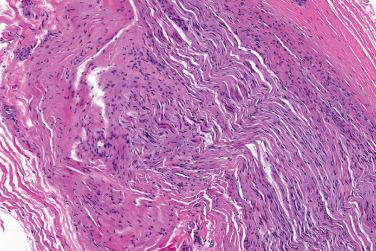
A benign lesion, most likely a hamartoma, characterized by proliferation of hyperplastic peripheral nerves in disorganized pattern, surrounded by frequently incomplete capsule containing perineurial cells
Multiple mucosal neuromas
Associated with the multiple endocrine neoplasia type 2B (MEN 2B) syndrome in the great majority of cases
Regarded due to their presence at birth or development shortly thereafter as an early marker of an underlying genetic disease
MEN 2B syndrome
Designated also as mucosal neuroma syndrome, Wagenmann–Froboese syndrome, or Gorlin syndrome
An autosomal-dominant inherited hamartoneoplastic syndrome
About 50% of patients present with sporadic mutations
Over 95% of cases due to a specific germline single-point mutation at codon 918 in exon 16 of the RET gene on chromosome 10 resulting in the replacement of methionine by threonine
Defining features of the syndrome include multiple mucosal neuromas, medullary thyroid carcinoma (in virtually all patients), Marfanoid body habitus with typical dysmorphic facies (features present in about 75% of the patients: widely set eyes, thickening and eversion of upper eyelid margins, visible tarsal plates, large and prominent eyebrows, flat nasal bridge, enlarged and nodular lips, elongated face), pheochromocytoma (in about 50% of patients, half of them multiple and frequently bilateral), and gastrointestinal (ganglio)neuromatosis (present in about 30% of patients, most commonly in the large and small bowel)
Patients presenting with typical physical features of MEN 2B but lacking identifiable germline mutation(s) and endocrinopathy likely represent a subgroup of the syndrome, designated as pure mucosal neuroma syndrome
Very rare association with dermal hyperneury even in clinically normal skin
Equal gender distribution
Usually present at birth or develops shortly thereafter
Solitary mucosal or cutaneous lesions, not associated with MEN 2B, appear to develop in older patients
Dome-shaped papules or small nodules covered by normal mucosa
Size about 5 mm in largest diameter
Sites of predilection include oral mucosa (lips, buccal area, gingivae, palate, tongue), but also eyelids, conjunctiva, and sclera
Cutaneous involvement in MEN 2B much more infrequent
Present as small papules or nodules, skin colored
Diverse sites of origin, including perinasal area, pinna, and face, less often on trunk
Widespread cutaneous neuromas (over 70) in association with macular amyloidosis on the back reported in a single patient
Dermal hyperneury consists of the presence of increased normal nerve bundles within the dermis
Solitary lesions not associated with MEN 2B also reported in the larynx, hard palate, and bronchial mucosa
Multiple intraosseous neural hyperplasia(s) in maxillary bone also reported and is thought to be highly suggestive for MEN 2B
No treatment generally required
Surgical treatment usually related to the location-induced functional impairment
Occurrence at particular location(s) (e.g., vocal cords) can be life threatening
Poorly circumscribed nodular or multinodular (plexiform) arrangement(s) of hyperplastic peripheral nerves in the subepithelial stroma or dermis
Haphazardly arranged, disorganized, interlacing fascicles of Schwann cells and axons
Nuclear palisading of Schwann cells can occasionally be seen and usually represents a focal phenomenon
Mitoses and nuclear pleomorphism absent
Hyperplastic nerves surrounded at the periphery of fascicles by a discontinuous layer of perineurial cells
Schwann cells strongly positive for S100 protein
Perineurial cells highlighted by EMA
Traumatic neuroma
Solitary circumscribed neuroma
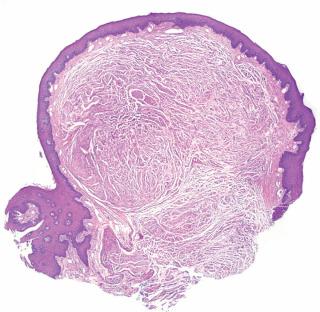
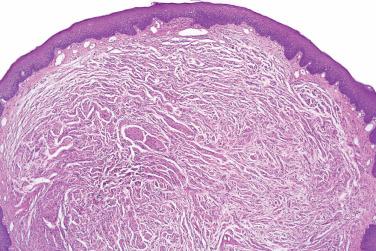
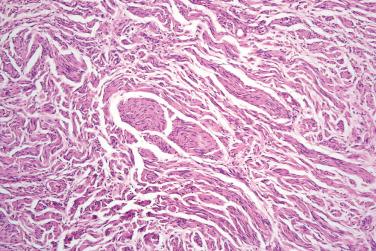

A hamartomatous dermal proliferation composed of mature ganglion cells and fascicles of hyperplastic nerve fibers with Schwann cells and axons
No gender predilection
Wide age distribution (0–92 years), most common in the fourth decade of life
Asymptomatic, flesh-colored, dome-shaped, sometimes verrucous papule or groups of papules with occasional linear arrangement(s)
Solitary lesions predominate, multifocal occurrence exceptional
Size about 1 cm in greatest diameter in cases of a solitary papule
Predilection for the trunk, followed by extremities, head and neck, and acral locations
Diagnosis generally not suspected on clinical grounds
Excision usually performed due to other suspected pathology
Complete excision curative
Well-circumscribed, nonencapsulated proliferation
Composed of mature ganglion cells and fascicles of hyperplastic nerves with Schwann cells and axons
Proportion of the component varies among the lesions
Components usually intermingled, but can be separated
Ganglion cells characterized by
Abundant eosinophilic to basophilic cytoplasm
Vesicular, eccentrically placed nuclei
Prominent nucleoli
Oval to stellate-shaped morphology
Retraction artifact between ganglion cells and surrounding stroma
Hyperplastic nerves characterized by proliferation of
Spindle-shaped Schwann cells with elongated and slightly wavy nuclei forming bundles and fascicles
Axons arranged in interweaving fascicles
Epidermal changes include acanthosis, papillomatosis, hypergranulosis, and hyperkeratosis
Features indistinguishable from seborrheic keratosis can also be seen
Additional changes include
Stromal desmoplasia
Focal myxoid change
Fatty metaplasia
Chronic inflammatory cell infiltrate composed of lymphocytes and macrophages
Ganglion cells strongly positive for synaptophysin, c-kit (CD117), and CD56; nearly always positive for neuron-specific enolase (NSE) and neurofilament; and positive for S100 protein
Schwann cells positive for S100 protein
Ganglion cell choristoma
Entrapment of ganglion cells by neurofibroma
Skin metastasis of a well-differentiated neuroblastoma (maturation into ganglioneuroma)
Benign and malignant melanocytic proliferations
Reticulohistiocytoma
Epithelioid fibrous histiocytoma

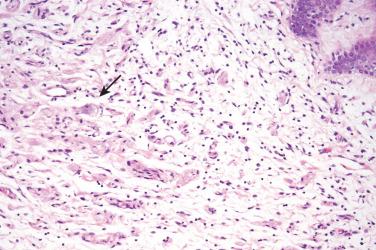
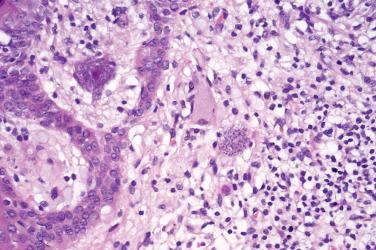
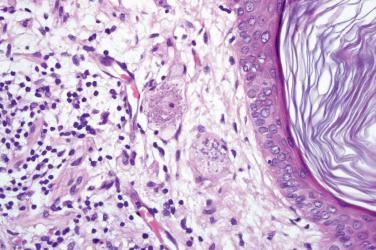
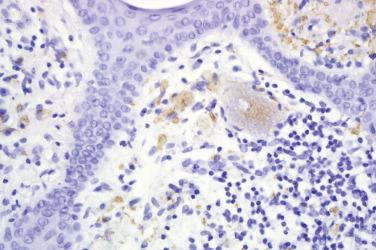
A hamartomatous proliferation of capillaries in the background of bland spindle cells showing neural differentiation
May represent a cutaneous marker for subsequent development of a malignant rhabdoid tumor
Infancy and early childhood
Not distinctive
Benign
No treatment generally required
Dermal proliferation
Small capillaries
Background proliferation of bland, spindle-shaped cells
Spindle cells neuron specific enolase positive
Various nerve sheath tumors
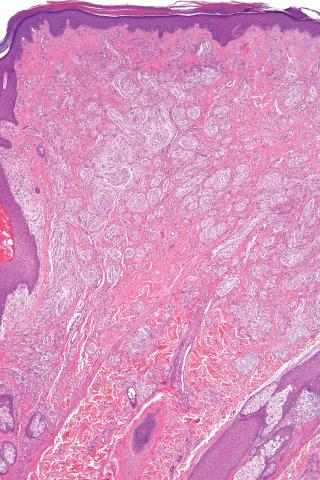
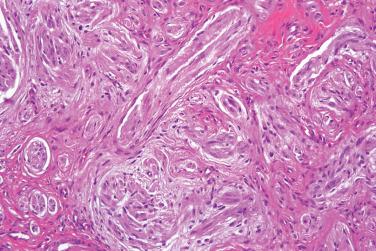
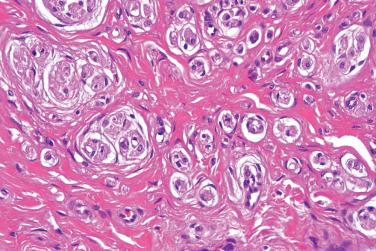
A benign proliferation composed of fascicles, nests, and whorls of Schwann cells, admixed with a variable number of axons, usually surrounded by an incomplete capsule containing perineurial cells
Likely represents a reactive proliferation, a distinctive form of neuroma generally not associated with previous trauma within a small nerve
Originally reported as palisaded encapsulated neuroma
Equal gender distribution
Most common in age groups between 30 and 60 years
Generally not associated with particular neurocutaneous syndrome(s), like neurofibromatosis, multiple endocrine neoplasia (MEN), Cowden syndrome, Bannayan–Riley–Ruvalcaba syndrome, or Gorlin syndrome
Solitary pink or flesh-colored papule or small nodule
Slowly growing, dome shaped, and firm
Asymptomatic or slightly painful
Size between 0.2 and 0.6 cm
Multiple lesions an exception
Synchronous occurrence of multiple lesions in a linear distribution on both hands (palms and fingers) reported recently
Loss of hair follicles and hairs in areas of skin overlying the lesion usually noted
Predilection for the face, especially areas close to the interface between skin and mucosal sites
Less frequent sites include neck, trunk, shoulders, proximal extremities, and acral sites
Mucosal surfaces can also be affected, including oral and nasal mucosa and glans penis
Complete excision curative
Recurrences after incomplete/marginal excision unlikely
Nodular and less commonly multinodular (plexiform) proliferation in the dermis with exceptional extension into the subcutaneous fatty tissue
Main components include Schwann cells, axons, and perineurial cells
Schwann cells forming broad intersecting elongated fascicles, nests, or whorls of bland spindle cells
Nuclei pointed at ends, but also plump, fusiform, and wavy
Palisading of nuclei with formation of Verocay bodies an exception; if present, generally a focal phenomenon
Mitoses absent or exceptional
Nuclear pleomorphism absent or mild and limited
Cytoplasm poorly delineated, pale, and eosinophilic
Fascicles separated by artifactual clefts, also present at the peripheral aspects of the proliferation
Axons
Arranged in parallel to the orientation of the fascicles
Usually evenly distributed and numerous
Axon(s) to Schwann cells ratio usually does not exceed 1 : 2 (A:SC ≤1 : 2)
In rare cases, their distribution can be focal and scarce
Perineurial cells
Within the discontinuous capsule at the periphery of the lesion
Not present in between Schwann cells within the lesion
Preexistent peripheral nerve can be identified in about 50% of the lesions
Serial sections may be necessary to demonstrate this phenomenon
Histological variants include epithelioid, multinodular (plexiform), and vascular
Epithelioid variant, as the name implies, features more epithelioid cells with round to oval nuclei and more prominent eosinophilic cytoplasm
Multinodular (plexiform) variant essentially corresponds to multiple interconnecting nodules representing a single lesion sectioned at multiple planes throughout the dermis
Vascular variant is characterized by an increase in cavernous-type blood vessels with possible thromboses and perivascular hyalinization (“ancient-like” changes)
Additional histological features
Overlying epithelium normal, atrophic, or hyperplastic
Myxoid change and stromal mucin, rarely extensive
Limited inflammatory cell infiltrate composed of lymphocytes and, rarely, eosinophils
Limited collagenized connective tissue stroma
Schwann cells positive for S100 protein and collagen type IV
Axons can be delineated by neurofilament stain
Perineurial cell population EMA, GLUT-1, and/or claudin-1 positive
GFAP staining consistently negative
(Multiple) mucosal neuroma(s)
Traumatic neuroma
Neurofibroma
Schwannoma
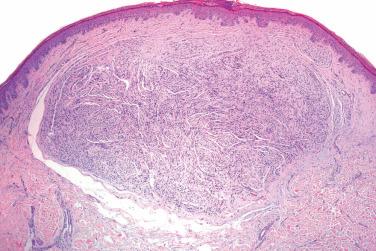
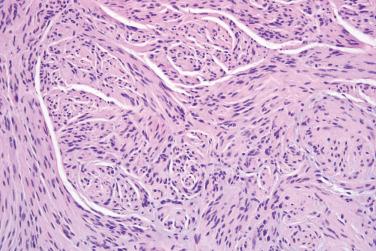
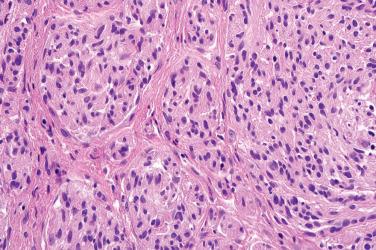
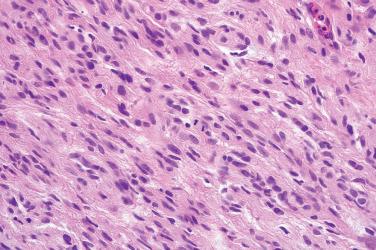
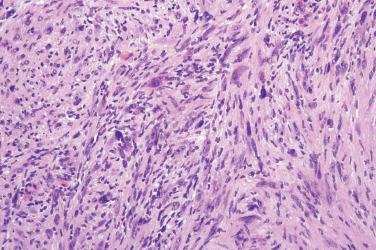
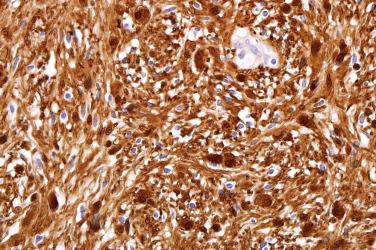
A distinctive benign proliferation composed of numerous thickened and enlarged nerves surrounded by a perineural epithelial sheath, restricted to the superficial dermis
Fewer than 10 cases reported
Slight female predominance (F:M = 4 : 3)
Adult patients (from 43 to 86 years, mean age 63 years)
Solitary erythematous plaque, papule, or nodule
Size from 0.5 to 2 cm in greatest diameter
Asymptomatic, pruritic, or painful
Exclusively reported on the skin of the back so far
Simple excision curative
No recurrences reported
Proliferation restricted to the papillary and superficial reticular dermis
Numerous thickened peripheral nerves surrounded by perineural epithelial sheath
Peripheral nerves
Disorganized proliferation
Occasionally display parallel orientation to the surface epidermis
May not be associated with perineural epithelial sheath, especially at the periphery of the lesion
Perineural epithelial sheath
Composed of regular squamous epithelium, likely of infundibular derivation
Cornification generally preserved with formation of dyskeratotic keratinocytes, presence of granular cell layer, and orthokeratotic basket-weave keratin
Epithelial elements only can occasionally be seen, not associated with peripheral nerves, especially in the central parts of the lesion
Epithelial sheath can be absent, especially at the peripheral aspects of the lesion, composed of thickened nerves only
Additional features
Perineural inflammatory cell infiltrate composed of lymphocytes and plasma cells, variably prominent
Minimal and delicate perineural fibroplasia
Myxoid/mucinous perineural stromal degeneration
Overlying epidermis usually normal
No connection to the epidermis or adnexal structures
Nerve bundles
Consistent positivity for S100 protein, neurofilament, CD57, and nerve growth factor receptor
Perineural epithelial sheath(s)
Strong positivity for CK-MNF116 and less intense positivity for CK-AE1/AE3
Negative for CAM5.2, EMA, and CEA
Traumatic neuroma
Idiopathic neuroma
Reactive neuroepithelial aggregates
Cutaneous hamartomas containing nerve fibers
Neurofollicular hamartoma
Congenital neural hamartoma
Striated muscle hamartoma/rhabdomyomatous mesenchymal hamartoma
Reexcision perineural invasion by nonneoplastic squamous epithelium
Perineural infiltration by epithelial tumors (e.g., squamous cell carcinoma, basal cell carcinoma, adenoid cystic carcinoma) or keratoacanthoma
Dermal hyperneury
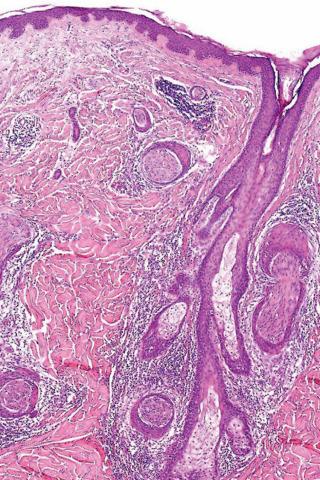
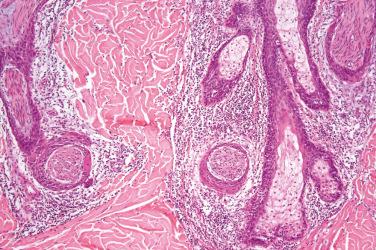
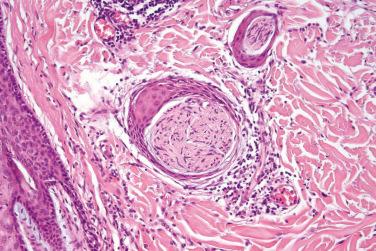
A benign peripheral nerve sheath tumor composed of Schwann cells
Equal gender distribution
Most common in the fourth and fifth decade of life
Slowly growing, painless swelling or nodule
Pain on percussion over the nerve (Tinel sign) present in over 90%
Multiple lesions can be associated with neurofibromatosis type 2
Multiple nonintradermal schwannomas in the absence of vestibular schwannomas can represent part of a schwannomatosis, an autosomal-dominant multiple neoplasia syndrome associated with a mutation in the SMARCB1 tumor suppressor gene located on chromosome 22q11
Benign tumor with very low malignant potential
Complete excision generally curative
Biphasic morphological pattern, designated as Antoni A and Antoni B areas, intermixed and in variable proportions
Antoni A areas
Cellular component
Closely packed spindle cells with wavy, elongated, and tapering nuclei
Cytoplasm ill defined, eosinophilic
Verocay bodies: two rows of nuclear palisading separated by Schwann cell processes
Mitoses rare
Degenerative nuclear pleomorphism
Stroma frequently hyalinized or collagenized with focal dystrophic calcifications
Small blood vessels with frequently hyalinized vessel walls
Antoni B areas
Hypocellular component
Irregularly distributed spindle and stellate cells
Abundant myxoid stroma
Scattered chronic inflammatory cell infiltrate
Small blood vessels with frequently hyalinized vessel walls
Degenerative changes not uncommon, including deposition of hemosiderin and microcystic change
Very rarely schwannoma can show Pacinian differentiation
Such lesions were previously considered neurofibromas with Pacinian features
These are not associated with neurofibromatosis, but have been associated in a few cases with vascular malformations
Strong nuclear and cytoplasmic S100 protein positivity
Capsule contains EMA-positive perineurial cells
Aberrations on chromosome 22 frequent (loss of 22q or monosomy of chromosome 22)
Solitary circumscribed neuroma
Neurofibroma
Leiomyoma
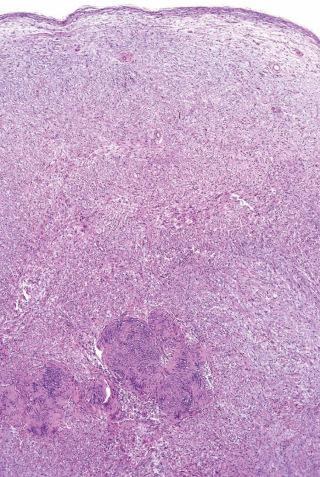
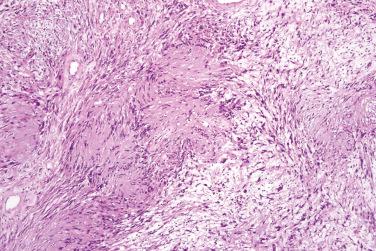
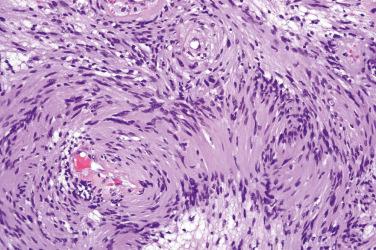
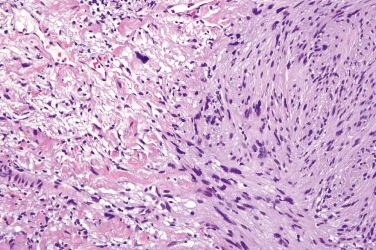
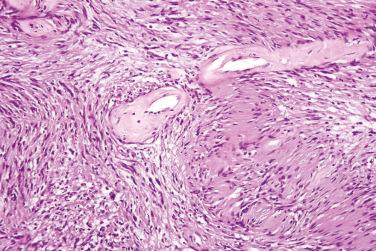
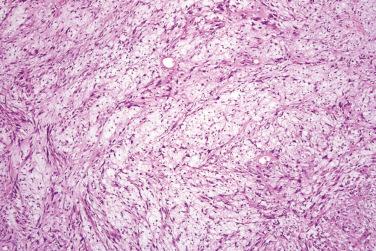
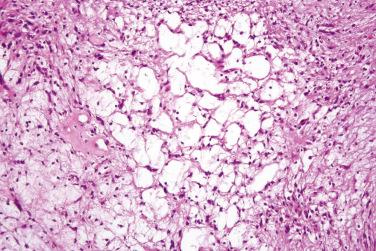
A variant of schwannoma characterized by multinodular (plexiform) proliferation of Schwann cells
The majority of the tumors occur in the superficial nerves; origin from major peripheral nerves much more uncommon
Represents about 5% of schwannomas
No sex predilection
Wide age distribution, but most common in young adults (fourth decade of life)
Congenital/childhood occurrence signifies possible association with neurofibromatosis type 2 or schwannomatosis, especially when lesions are multiple
Slowly growing, generally nonpainful nodule
Single lesions predominate
Size usually less than 2 cm, but giant variants also reported
Multiple lesions can develop within the single anatomical area, or are widely distributed
Most common at superficial locations (dermis/subcutis) (90%), with predilection for the head and neck, upper extremities, and trunk
Mucosal sites (e.g., oral cavity), deep soft tissues (about 50% develop in extremities, followed by pelvis), or visceral locations (gastrointestinal tract) affected less frequently (in about 10%)
Association with neurofibromatosis type 2 (NF2) (with multiple lesions in the dermis and subcutis) and, less often, with schwannomatosis, whereas occurrence in the setting of neurofibromatosis type 1 (NF1) much more uncommon
Plexiform schwannoma in the setting of NF1 and NF2 exceptionally associated with macrodactyly
Benign tumors with no malignant potential, but may cause severe nerve dysfunction
Recurrences rare, usually after incomplete excision
Complete excision curative
Tumors developing within plexiform schwannoma in exceptional cases
Epithelioid angiosarcoma
Intratumoral metastases, mainly from the breast
Antoni A elements (cellular) predominant/exclusive component of the lesions
Antoni B elements present focally or lacking altogether
Generally encapsulated by thin layer of perineurial cells, which may be discontinuous/lacking immediately beneath the surface, especially at the mucosal sites
Increased cellularity, mitotic activity, nuclear pleomorphism, and focal areas of necrosis (12% of deep-seated variants of plexiform schwannoma) do not have any biological significance
S100 protein positive
Chromosomal abnormalities appear to be different than in conventional schwannoma, with trisomy of chromosome 17 and 18, not associated with chromosome 22 aberrations
Plexiform neurofibroma
Malignant peripheral nerve sheath tumor

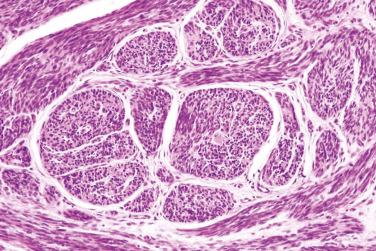
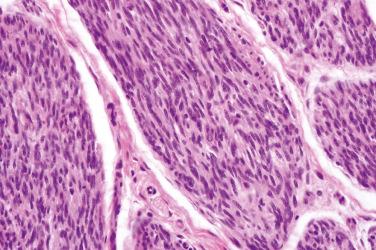
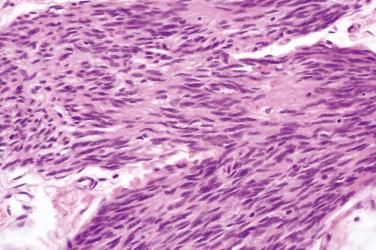
A subtype of schwannoma characterized by extensive degenerative changes thought to result from vascular insufficiency, usually in a long-standing lesion
Elderly patients
Occurrence in pediatric population most unusual
Represents about 0.8% of soft tissue tumors
Generally a long-standing lesion
Predilection for deeper locations, particularly soft tissues of the head and neck, thorax, retroperitoneum, pelvis, and extremities
An exceptional case occurring within the lymph node has also been reported
Lesions generally follow a benign clinical course
Malignant transformation of ancient schwannoma an exceedingly rare phenomenon with fewer than 10 such cases reported (see malignant peripheral nerve sheath tumor)
Complete excision curative
Degenerative nuclear atypia characterized by nuclear hyperchromasia, pleomorphism, intranuclear cytoplasmic pseudoinclusions, and often multilobated nuclei
Mitotic activity absent or very low
Relative loss of cellular Antoni A areas with increase in the proportions of hypocellular areas
Recent/old hemorrhage with extravasation of erythrocytes or hemosiderin deposition
Pseudocystic areas
Calcification and osseous metaplasia
Xanthomatous change and/or formation of cholesterol clefts
Vascular thrombosis in different stages of organization
Perivascular hyalinization
Stromal edema, hyalinization, and fibrosis
Background changes of conventional schwannoma
See conventional schwannoma
See conventional schwannoma
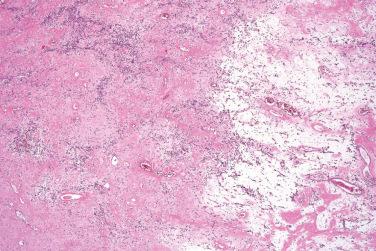
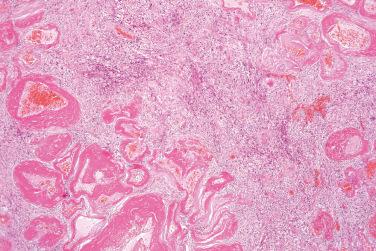
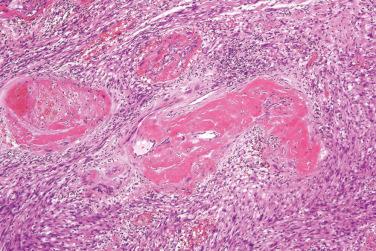
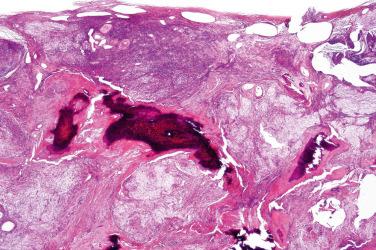
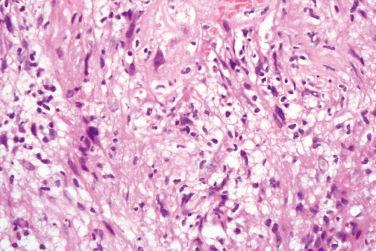
A histological variant of schwannoma characterized by high cellularity, fascicular growth pattern, and mild cytological atypia, but associated with a benign biological behavior
Middle-aged adults
Plexiform variant of cellular schwannoma can be congenital and shows predilection for childhood
Represents about 5% of schwannomas
Association with neurofibromatosis rare
Slowly growing nodular proliferation
Predilection for paravertebral areas of the mediastinum and retroperitoneum
Neurological disturbances related to the site of origin; erosion of the bone occasionally present
Plexiform variant of cellular schwannoma
Multinodular occurrence, occasionally associated with a rapid growth
Predilection for extremities
Generally lacks association with neurofibromatosis
An unusual collision of cellular schwannoma and plexiform neurofibroma in the absence of neurofibromatosis reported recently
Benign clinical course with lack of malignant alteration
Recurrences after incomplete excision common, with increased mitotic activity demonstrated to be predictive of possible recurrence
Complete excision curative, but might be difficult to achieve due to the site of origin
Predominance of highly cellular Antoni A areas with spindle cells growing in interlacing fascicles, but additional storiform or whorled pattern not uncommon
Mitotic activity
Typically present and may be as high as 10 mitoses per 10 high-power fields
Atypical mitoses absent
Isolated microfoci of necrosis not uncommon, but larger areas of necrosis or multifocal necrosis an exception
Mild to moderate nuclear pleomorphism associated with nuclear hyperchromasia
Absence of Verocay bodies, but vague nuclear palisading can be present at least focally
Additional features
Foamy macrophages, may be particularly prominent
Inflammatory cell infiltrate, usually composed of lymphocytes
Diffuse and strong S100 protein positivity
Malignant peripheral nerve sheath tumor
Leiomyosarcoma
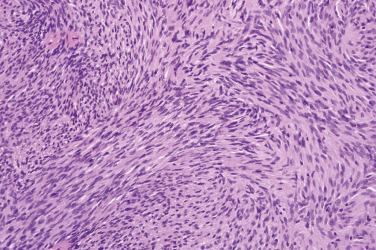
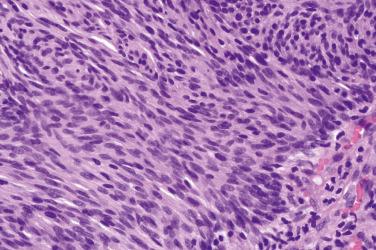
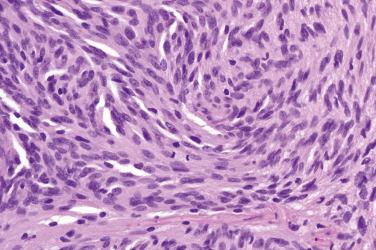
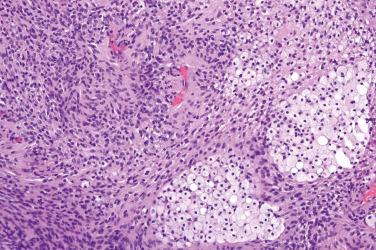
A variant of schwannoma characterized by the predominance of epithelioid Schwann cells growing in cords and nests
Female predominance
Adult patients, most common in the fifth decade of life
Slowly growing, asymptomatic nodule
Lesions can also be painful
Generally less than 2 cm in greatest diameter
Predilection for the head and neck area, followed by the back
Rare sites include intracranial nerves and neck of the bladder
Benign lesion with no malignant potential
Recurrences rare, even after incomplete excision
Conservative excision generally curative
Highly cellular, multinodular proliferation surrounded by a thin capsule (may be absent in rare instances)
Lesional cells grow in small nests, trabeculae, cords, or strands (can be separated by artifactual clefts)
Epithelioid cells with round to oval nuclei containing small nucleoli and well-defined, abundant eosinophilic cytoplasm
Mitoses rare (usually up to 1 per 10 high-power fields), atypical mitoses absent
Necrosis absent
Focal symplastic change with nuclear pleomorphism and intranuclear cytoplasmic pseudoinclusions frequently present
Transitions to classic schwannoma can be seen focally in a proportion of cases
Medium-sized blood vessels with hyalinized walls
Myxoid matrix
Plexiform variant characterized by
Multiple nodules composed of epithelioid Schwann cells in the dermis and subcutis
Each nodule surrounded by a thin layer of perineurial cells
Up to 5 mitoses per 10 high-power fields
Diffuse and strong nuclear and cytoplasmic S100 protein positivity
EMA, melan A, CD34, various cytokeratins negative
Proliferative activity (Ki-67) generally low
Epithelioid neurofibroma
Myoepithelial tumors
Epithelioid malignant peripheral nerve sheath tumor
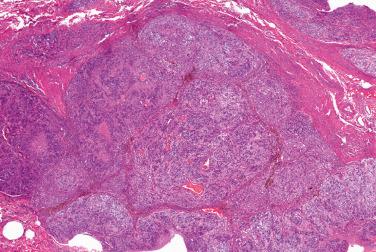
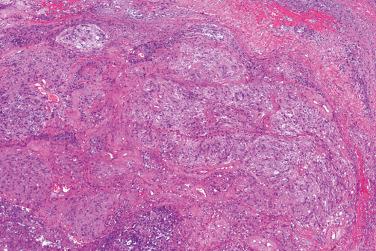
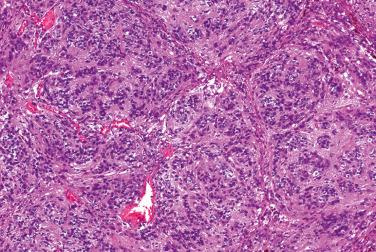
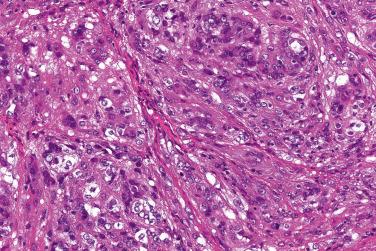
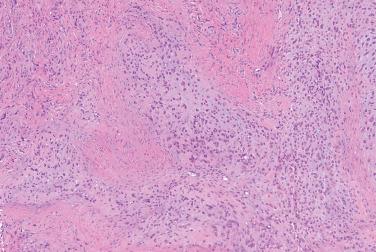
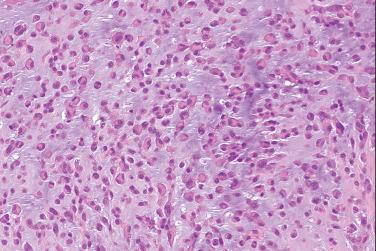
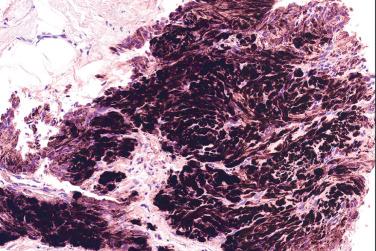
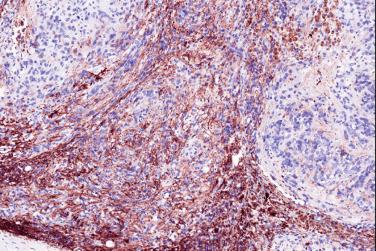
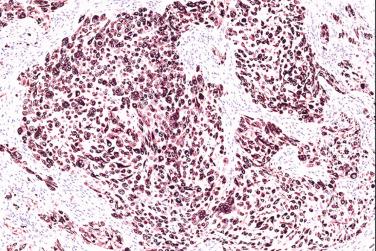
A variant of schwannoma characterized by proliferating Schwann cells forming a rosette-like growth pattern
Female predominance (F:M = 6 : 1)
Wide age distribution, most common in fourth decade of life
Not associated with neurofibromatosis
Solitary asymptomatic nodule, occasionally painful
Predilection for neck, followed by trunk and extremities
Unusual locations include vulva and orbit
Benign lesion
Complete excision curative
Well-circumscribed and encapsulated
Dermis and/or subcutis
Lesional cells small with round to oval nuclei, indistinct nucleoli, and scant cytoplasm
Epithelioid morphology not uncommon, either focally or more extensive
Formation of rosette-like structures around blood vessels or collagenous cores
Mild nuclear atypia occasionally present
Mitoses generally absent
Necrosis absent
Multinodular/plexiform growth pattern in a single case
Typical features of conventional schwannoma present at least focally in the majority of cases
Diffuse and strong S100 protein positivity
Occasional focal positivity for synaptophysin, GFAP, and neuron specific enolase
EMA delineates perineurial cells within the capsule
Neuroblastoma
Dendritic cell neurofibroma with pseudorosettes
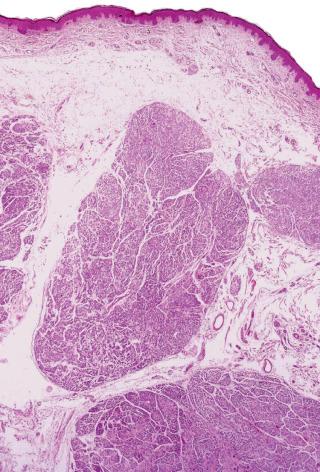
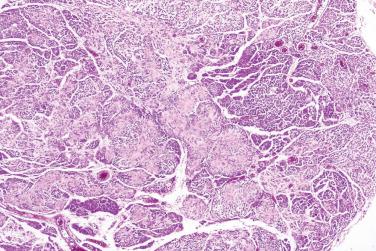
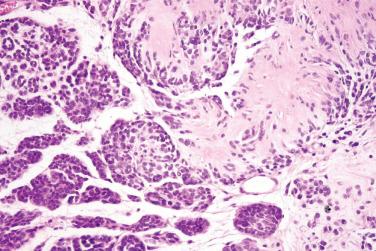
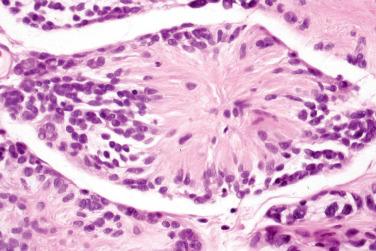
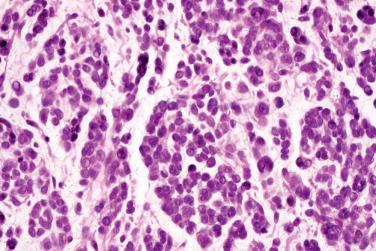
A distinctive variant of schwannoma characterized by anastomozing and intersecting cords/strands of spindled Schwann cells with the formation of a delicate microcystic or reticular growth pattern
Wide age distribution (11–93 years, median 63 years)
No gender predominance
Slowly growing solitary nodule
Multinodular growth reported in a single case, presented with facial swelling
Size from 0.4 to 23 cm (median size 4.3 cm)
Predilection for visceral sites, especially gastrointestinal tract (isolated cases reported also in adrenal gland, respiratory tract, pancreas, cervical spine)
Rare sites include subcutis and deep soft tissue
Benign clinical course
No recurrences after complete excision
Lesions at visceral sites generally well circumscribed but not encapsulated
Cutaneous tumors encapsulated
Spindle cells growing in anastomozing and interconnecting strands with formation of a microcystic/reticular and, less often, cribriform growth pattern
Nuclei round, oval, or tapered with inconspicuous small nucleoli
Nuclear atypia generally absent
Mitoses rare (usually fewer than 3 per 50 high-power fields)
Cytoplasm ill defined, eosinophilic
Myxoid material or fibrillary collagen occasionally present within microcystic/reticular structures
Intervening stroma myxoid, fibrillary, or sclerotic/collagenized
Areas resembling conventional schwannoma, foci with epithelioid morphology, and fascicular growth pattern occasionally present
Scattered inflammatory cell infiltrates composed of lymphocytes (aggregates or formation of germinal centers rare)
Strong and diffuse nuclear and cytoplasmic S100 protein positivity
Variable positivity for GFAP and CD117 (c-kit)
Negative for various cytokeratins, smooth muscle actin, desmin
Extraskeletal myxoid chondrosarcoma
Perineurioma
Myoepithelial tumors
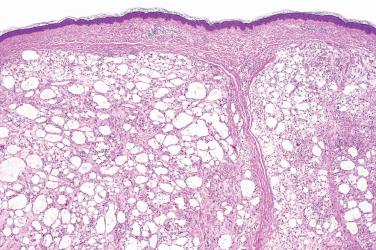
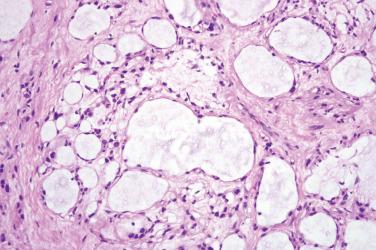
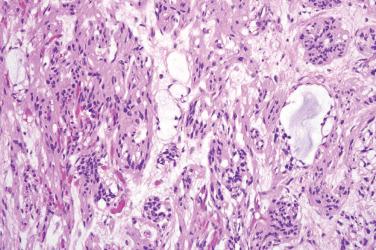
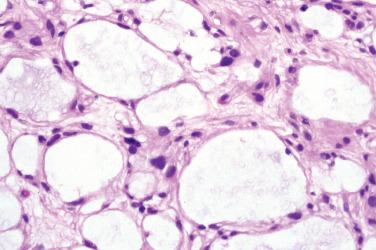
A benign, peripheral, nerve sheath tumor composed of an intimate admixture of Schwann cells and perineurial cells in variable proportions
Equal gender distribution
Most common in the fourth decade of life, although age distribution is quite broad (about 70% develop from second to fifth decade)
Association with neurofibromatosis type 1, neurofibromatosis type 2, and schwannomatosis appears to be more frequent than initially estimated, especially for multiple lesions
Solitary, slowly growing nodule
Generally asymptomatic, occasionally painful
Mean size about 3 cm
Predilection for limbs, head and neck, and trunk
Lesions can also develop at diverse sites, including visceral locations (gastrointestinal tract), mucosal sites (oral mucosa), lymph nodes, and external genital area
Two lesions reported recently, developed after previous irradiation, but the causative relationship uncertain
Benign proliferation
Local recurrence rare
Malignant alteration an exception (demonstrated in a single case)
Well-circumscribed (infiltrative growth rare) and unencapsulated proliferation in the dermis and/or subcutis
Growth patterns include storiform, whorled, fascicular, with nuclear palisading, plexiform, and lamellar
Two cell populations intimately admixed (may be difficult to separate on sections stained with hematoxylin and eosin [H&E])
Schwann cells: nuclei more plump or tapering, eosinophilic cytoplasm with indistinct cell borders
Perineurial cells: slender nuclei with bipolar cytoplasmic processes
Mitoses usually absent
Degenerative nuclear atypia present in about 25% of the lesions
Myxoid and/or hyalinized stroma
An exceptional example with triple hybrid components, including schwannomatous, neurofibromatous, and perineuriomatous differentiation, has recently been reported in the nasal cavity
S100 protein–positive Schwann cells usually comprise about 50% to 60% of the population
EMA-positive and frequently also claudin-1–positive perineurial cells represent about 30% to 40% of the tumor cell population
No tumor cells coexpressing S100 protein and EMA
CD34 usually diffusely positive
Variable positivity for GFAP
Neurofilament demonstrates entrapped axons in about one-third of the lesions
Congenital melanocytic nevus with areas of neurotization
Schwannoma
Low-grade malignant peripheral nerve sheath tumor
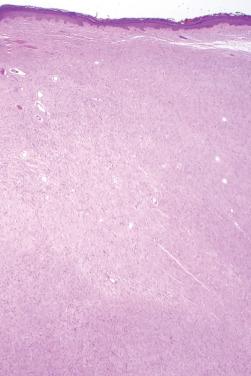
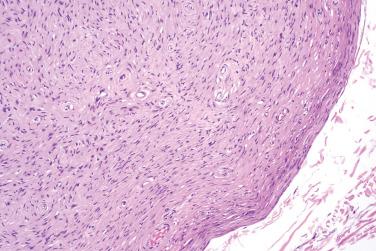

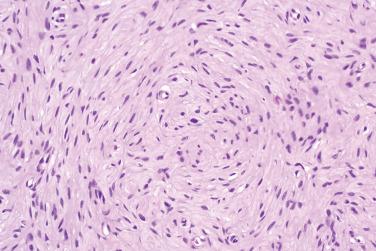
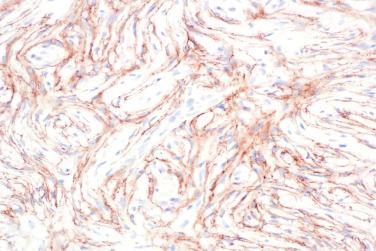
A benign, peripheral nerve sheath tumor composed almost exclusively of perineurial cells occurring in the dermis or dermis/subcutis
Perineuriomas are traditionally separated into tumors developing either within (intraneural) or outside (extraneural) peripheral nerves
Perineuriomas can represent distinctive component of hybrid tumors, like schwannoma-perineurioma, cellular neurothekeoma–perineurioma, neurofibroma-perineurioma, and perineurioma–granular cell tumor (see hybrid tumors )
Female predominance
Wide age distribution, but most common in the fifth decade of life
Solitary, slowly growing papule or a superficial nodule
Cutaneous lesions generally smaller than soft tissue counterparts, with a median size of less than 1 cm
Most common on lower limbs and trunk, with the exception of sclerosing variant showing special predilection for fingers and palm
Complete excision curative
Recurrences distinctly uncommon
Become a Clinical Tree membership for Full access and enjoy Unlimited articles
If you are a member. Log in here